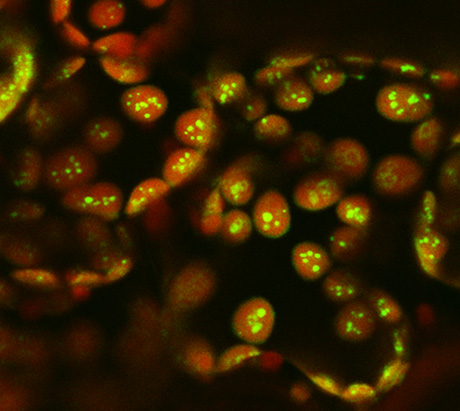Algal genes may boost efficiency, yield in staple crops
By Krishna Ramanujan

As humanity faces more mouths to feed thanks to a swelling global population, new research has taken a step toward employing genes from blue-green algae to improve staple crop photosynthesis – a potential improvement that could boost plant efficiency and increase yields.
Scientists at Cornell and the U.K.’s Rothamsted Research report using genes from blue-green algae – called cyanobacteria – to create micro-compartments inside photosynthesizing plant cells, an important breakthrough for improving photosynthesis.
The study was published online May 8 in The Plant Journal.
All plants employ an enzyme called Rubisco to fix carbon dioxide during photosynthesis, where plants combine carbon dioxide, water and light to make oxygen and sucrose; the plant uses sucrose for energy and to build new plant tissues.
But Rubisco reacts with both carbon dioxide and oxygen in the air. When it reacts with oxygen, increasingly in warmer temperatures, the rate of photosynthesis decreases and it lowers yields.
Blue-green algae also photosynthesize, but they employ a mechanism to concentrate carbon dioxide in polyhedral micro-compartments around Rubisco, so Rubisco reacts with carbon dioxide and not oxygen, making photosynthesis more efficient.
Until now “nobody had been able to show you can make this micro-compartment in plants,” said Myat Lin, the paper’s first author and a postdoctoral fellow in the lab of Maureen Hanson, a senior co-author of the study and Liberty Hyde Bailey Professor of Plant Molecular Biology at Cornell.
Lin devised a way to insert the algal genes for making the outer layer – known as the shell – of the micro-compartments into model tobacco plants, said Hanson.
Now that the researchers have a method to insert these shells into chloroplasts – the organelles in plant cells where photosynthesis occurs – the next steps will be to incorporate Rubisco, other proteins and an enzyme that helps transport carbon dioxide into Rubisco with the micro-compartments.
Martin Parry, Alessandro Occhialini, John Andralojc and Jean Devonshire, scientists at Rothamsted Research, are co-authors of the study.
The National Science Foundation and the Biotechnology and Biological Sciences Research Council in the U.K. funded the research.
Media Contact
Get Cornell news delivered right to your inbox.
Subscribe